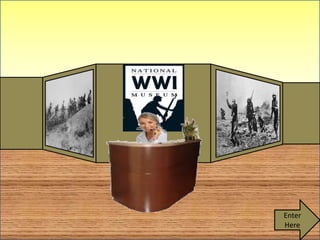
Brent Cournoyer
- 1. Enter Here
- 2. Causes of WW 1 Trench Lobby Warfare
- 3. Trench Warfare Why the U.S Causes of Entered WW 1 WW 1
- 4. Why the U.S. entered the war Trench The U.S. Warfare In the war
- 5. The U.S. In the war Why the U.S. entered the Treaty of war Versailles
- 6. The Treaty of Versailles The U.S. in the war Lobby
- 7. Alliances Alliances- forming partnerships with other nations The Alliances contained The central powers which included Germany, Austria and the Ottoman Empire (were Turkey is now. The Allies which included Britain, France, Russia and later the U.S. Go Back
- 8. Militarism Militarism-building up of the military Military was built up for two reasons. 1) To protect their colonies 2) Peer pressure -They used a military draft to accomplish this. -Russia had the largest army ,Germany had the best trained, Britain had the largest navy Go back
- 9. Nationalism Nationalism-pride in ones country Nationalism in the WW 1 period -The pan-German movement was the hope to unite all German speaking people - The pan-Slavic movement was the hope to unite all Slavic(Russian) speaking people Example- In Bosnia 95% of people spoke Slavic but it is controlled by German speaking Austria. Go back
- 10. Imperialism Imperialism- competition for colonies European nations were competing for land. -They believed that “bigger was better. Examples- Africa and Bosnia Go back
- 11. Trench Warfare To protect their positions and to cut down on losses both sides dug trenches. At night supplies were brought in and scouts were sent out. At dawn and dusk attacks would come they would hit the enemy with artillery and go over the top of the trenches. The men had to go through barbwire, machine gun fire and craters Problems in the trenches included mud, rats, smell, body rot, cold, staying dry, maggots, lice and disease. Go back
- 12. Why the U.S. entered WW 1 1. Sinking of the Lusitania 2. Unrestricted submarine warfare 3. Zimmerman's note Go Back
- 13. Unrestricted submarine warfare The Sussex pledge: Germany promised not to sink any merchant ships without warning them first and rescuing the passengers. By 1917 German is defeating Russia on the eastern front they want a quick victory on the western front. -To do this they use Unrestricted submarine warfare. -They sink ALL ships headed toward allied nations. Go back
- 14. Zimmerman’s Note Zimmerman was a German official. -He sent a letter to Mexico asking them to attack the United States. -In exchange he promised that Germany would aid them in retrieving some of the land that we took from them(Mexico). Zimmerman Go back
- 15. Sinking of the Lusitania The Lusitania was a passenger ship that was secretly carrying ammunition. -A German submarine sunk the ship. -1,198 passengers died (128 were Americans). -President Wilson demanded that the Germans apologize and pay for the damages. Go back
- 16. The U.S. in the war General Pershing led the U.S. troops -By 1917 Germany controller Belgium, Italy and northern France. -By 1918 Russia has had a revolution and they have dropped out of the war. -By July 1918, the United states has 1 million troops in the war. -We cut off the German rail lines which supply there troops. -We attack through the Argonne Forest. It takes 47 days and 1.2 million soldiers. but we cut of there supply -By October 1918, Germany’s lines are crumbling. -In November , the Allies have captured the high ground and Germany surrenders on the 11th hour, the 11th day of the 11th month in 1918. The war is then over. Go back
- 17. Treaty of Versailles The treaty that ended the war was the Treaty of Versailles The three main results were: 1. Created new colonies -Russia: Poland, Finland, Latvia, Lithuania, Estonia. -Austria-Hungary: Austria, Hungary, Czechoslovakia, Yugoslavia. -Ottoman Empire; divided up between the Allies. 2. Punished Germany: -They must take full responsibility for the war and pay for the war(33 billion dollars) 3. Create the League of nations -A organization of countries designed to maintain peace and stability. But it was the treaty was a reason for WW 2. Go back